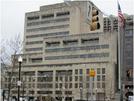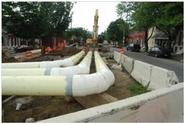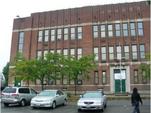|
Capital Improvement Program (CIP) 101:
The CIP Process
The Capital Improvement Program or CIP
is a budgetary plan that guides the City’s investment in necessary physical
improvements. The City Charter requires
the Planning Commission to prepare a six-year recommended CIP each year. The first year of the six year program is the
basis for the capital component of the Ordinance of Estimates, adopted by City
Council, to fund projects in the current budget year. Typical capital improvement
projects include new or major renovations to City facilities, such as
buildings, roads, parks, sewers, etc.
 |
|
The Benton Building at 417 E. Fayette St, home of the Planning Department, is being proposed for a facelift, insulation and waterproofing in the FY 2014-19 CIP.
|
The Department of Planning is currently
working through the FY 2014-19 CIP process, and the next step will be
Planning Commission Review at public hearings on February 14th and
28th at 1:30 pm in the Planning Department, 417
E. Fayette Street, 8th floor. The public is welcomed to
attend.
The FY 2014-19 CIP Timeline:
September 2012: Planning provided agencies
with targets for each fund source and instructions for submitting CIP requests
for FY 14-19
November 30, 2012: Agency FY 14-19 CIP requests were due to Planning Department
January 10 and 17, 2013: Select
agencies presented FY 14-19 CIP priorities to Planning Commission
February 14, 2013: Planning staff
will present its FY 14-19 CIP recommendations to Planning Commission
February
28, 2013: Planning Commission votes on recommended FY
14-19 CIP
March 2013: Board of
Finance review of recommended FY 14-19 CIP
April 2013: Board of Estimates
approval of recommended FY 14-19 CIP
June 2013: City Council
adoption of Capital Budget for FY 2014
July 1, 2013: Fiscal Year 2014 begins
CIP at Work: At right is an image of federally mandated sewer upgrades in progress. |
|
 |
CIP Evaluation
Criteria
When Planning Department staff and the Planning Commission review CIP
requests from City Agencies, they are looking for requests that are specific,
clearly capital in nature, and compelling.
Compelling requests must also meet one or more of the following
criteria:
-
Necessary to protect public health and safety.
-
City funding will leverage other fund sources.
-
Capital investment will result in operating savings.
-
Fulfills a state or federal mandate.
-
Necessary to implement a priority housing or economic
development project (ex. supports the Red Line).
-
Promotes private-public partnerships.
-
Implements the City’s Comprehensive Master Plan, current
& future area master plans and/or agency/institution’s master plan
-
Implements the City’s Sustainability Plan
 |
|
CIP at Work: The 2014 CIP proposes design work for renovations and energy efficiency upgrades at Sarah’s Hope Shelter for Women and Children.
|
Sources of Funding:
General
Obligation Bonds (GO Bonds) –
With voter approval, the City borrows money for specific improvements by
selling General Obligation Bonds. General Obligation bonds are debt secured by
the full faith and credit of the City. General Obligation bonds are presented
to voters for approval every two years. Currently, the CIP includes $50 million in G.O.
Bonds each year.
General
Funds – Revenue received from various
payments to the City, such as property taxes and sale of property. General
Funds are mostly used for the operating budget, but Finance allocates a certain
amount for “pay-go” capital each year. The amount of General Funds varies from
year to year; currently, the target for FY14 is $4.7 million.
General
Funds Highway User Revenue (HUR) Eligible – Formerly known as Motor Vehicle Revenue (MVR). These funds
are State Highway User Revenues allocated by formula. These state funds are
restricted to eligible uses, such as transportation projects. The amount of
General Funds HUR Eligible varies from year to year; currently the target for
FY 14 is $8 million.
County
Transportation Bonds – Bonds issued by
the Maryland Department of Transportation to be repaid with future General Fund
Highway User Revenue. The CIP includes $33 million in County Transportation
Bonds for FY 14 and $15 million for FY 15. There are currently no County
Transportation Bonds programmed for FY 16 through FY 19.
State
Funds – Includes Open Space funds, Waterway
Improvement Funds and Economic Development Loans.
Federal
Funds – Loans and grants from the Federal
Government including CDBG, highway funding and enhancement grants.
Water
and Wastewater Revenue Bonds
– Bonds issued by DPW to be repaid with future water and wastewater revenue
(water bills).
Utility
Funds –Funds from current operating revenues
such as water bills and conduit fees.
Other – County Grants, private monies, critical area offset
funds, etc.
Uses
of Funding:
The following is a sampling of the projects
that were approved
for funding in the Fiscal Year 2013 CIP:
-
Mount Vernon Place Conservancy - Restoration Project
-
Critical Area Buffer Offset Program
-
Historic Public Monuments
-
Convention Center-Eastside Renovations
-
New Southwest Area Elementary School (Uplands)
-
Elm Ave, Mullen, B&O, and Federal Hill Playlot
Renovations
-
Edmondson Ave Bridge Reconstruction
-
Boston Street Reconstruction - Phase I & Phase
II
-
Baltimore Harbor Debris Collectors
 Above: Morrell Park Ball Field Renovations
-
Sewer System Rehabilitation Program - Dundalk
Sewershed
-
Wastewater Facilities Security Improvements
-
Urgent Needs Water Engineering Services
-
Park Heights Redevelopment
-
Urban Agriculture and Community Garden
Infrastructure
For
additional information, including CIP reports and maps from previous years,
visit our website. |